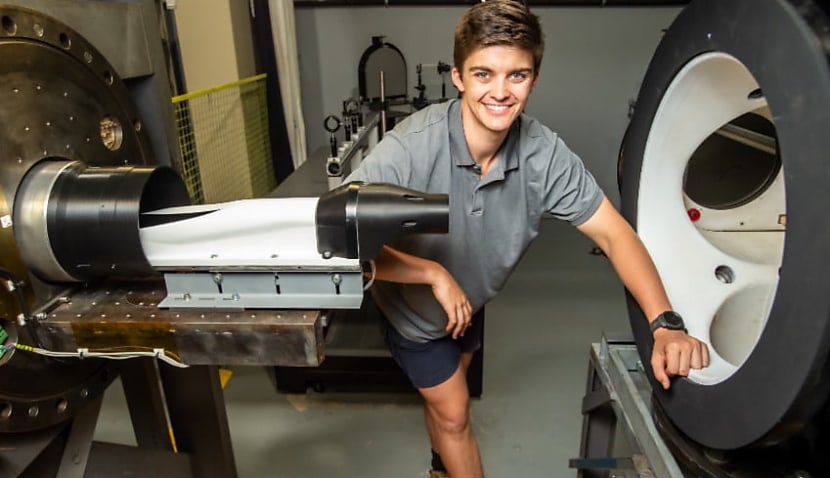
Lachlan Noller has been working on improving scramjet engines as part of his PhD research into high-speed travel options.
Under supervisor Fabian Zander, Noller has been working with the university’s trailblazing Hypersonics Group to find improvements to the team’s existing hypersonic technology.
“Essentially, what we’re doing is expanding the operation duration of scramjet inlets — super fast, experimental engines that move five times the speed of sound,” Noller said.
“My part involves developing new methods to help restart scramjets if or when they stop working.”
As part of the research, Noller and his colleagues in the Hypersonics Group carry out tests and experiments in their specially designed hypersonic wind tunnel.
The University of Southern Queensland (USQ) is home to the longest duration hypersonic wind tunnel in Australia, which puts them at the forefront of the groundbreaking hypersonic research occurring in Australia.
Noller, just 25 and two years into his PhD, has always been interested in machinery. Growing up on a cotton farm near Cecil Plains, Noller went from repairing farm equipment to working on some of the most complicated hypersonic engines in existence.
Speaking about his work, Noller praised the university environment that allowed him to work on his research.
“At the University of Southern Queensland, we are lucky enough to have Australia’s longest duration hypersonic wind tunnel, as well as leading scientists from across the world.”
While hypersonic tech — defined as flying at least five times the speed of sound — is nothing new, countries are currently racing to develop the next generation of vehicles and missiles that are so manoeuvrable in mid-air that they can’t be intercepted or detected.
There are currently two major ways it’s thought manoeuvrable hypersonic vehicles and missiles could work.
The first, known as a hypersonic cruise missile, would see a rocket blast to Mach 5 before using an air-breathing engine, or scramjet, to maintain its momentum.
The second, known as a glide vehicle, sees a rocket blast into the sky before releasing a separate hypersonic missile that has built up enough velocity to travel under its own speed.
The advances are also being used to create scramjet-powered, hypersonic spaceplanes, which could one day provide an alternative to rockets for taking satellites into space. USQ already has its own pioneering wind tunnel that can simulate the effect of Mach 5 speeds on vehicles and the heat it generates.
You can listen to Space Connect's podcast with USQ's Dr Fabian Zander, above.

Liam McAneny
Liam McAneny is a journalist who has written and edited for his University International Relations journal. He graduated with a Bachelor of Arts (International Relations) and Bachelor of Laws from the University of Wollongong in 2021. He joined Momentum Media in 2022 and currently writes for SpaceConnect and Australian Aviation. Liam has a keen interest in geopolitics and international relations as well as astronomy.
Send Liam an email at: [email protected]
Receive the latest developments and updates on Australia’s space industry direct to your inbox. Subscribe today to Space Connect here.









